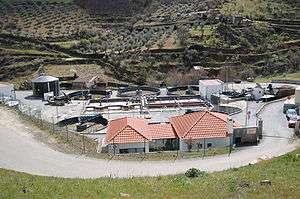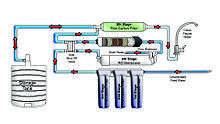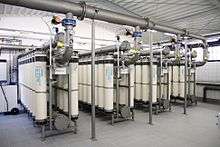Raw water
Raw water is natural water found in the environment and has not been treated, nor have any minerals, ions, particles or living organisms removed. Raw water includes rainwater, ground water, water from infiltration wells, and water from bodies like lakes and rivers. The characteristics of raw water include physical ones, such as taste, temperature, or turbidity, chemical ones, such as hardness, acidity/alkalinity, and ion content, and biological ones, such as organism presences. These characteristics can vary greatly depending on environmental conditions. Pollution can also effect raw water content.
Without treatment, raw water can be used for farming, construction or cleaning purposes.[1] Farmers use it for watering their crops or give to livestock to drink, storing it in man-made lakes or reservoirs for long periods of time. Construction industries can use raw water for making cement or for damping down unsealed roads to prevent dust rising. Raw water can also be used for flushing toilets and washing cars, as well as any other purpose that do not require it to be consumed by humans. Water in this form is considered raw, as opposed to water which has been treated before consumption, such as drinking water or water which has been used in an industrial process, such as waste water. Contaminants usually make raw water unsafe for drinking by humans without treatment. However, millions of people in developing countries rely on untreated raw water for their water supply, sometimes purifying it by boiling.[2]
Raw water flushing is a method of water conservation where raw water is used for flush toilets.
Composition
The composition of raw water is naturally variable, but commonly contains one or more of the following significant contaminants, in the form of dissolved ions, particles and living organisms:[3]
- Humic acid and other complex acids, produced by plant decay. These occur in peat and soil and may cause discolouration of water.
- Minerals which make water hard. Most common are carbonates of calcium and magnesium.
- Particles of clay and silt.
- Microorganisms such as bacteria, viruses, protozoa and their cysts. Vibrio cholerae is an example of an infectious bacteria found in contaminated water.
- Dissolved air molecules, especially oxygen
- Salt, which makes water brackish, having more salinity than fresh water, but not as much as seawater.
Other, less common, contaminants of raw water include:
- Natural radioactive particles.[4]
- Perfluorinated alkyl acids, such as perfluorooctanoic acid, which are group of pollutants that have been found in wastewater throughout Europe.[5] There are concerns these chemicals could contaminate raw water sources that are commonly used for drinking water.
- Endocrine disruptor compounds; chemicals that can interfere with the endocrine system causing cancerous tumors, birth defects, and other developmental disorders.[6]
These contaminants can be harmful to humans if they drink raw water containing them, or if the water is not treated properly before consumption. The contaminants can also have an effect on the local ecosystem. For example, endocrine disrupting chemicals can have harmful effects on fish populations living in natural lakes and rivers.[7] These growing health concerns have led to the development of guidelines, such HACCP (Hazard Analysis and Critical Control Points), for the production of safe drinking water from wastewater and raw water, and research into sustainable water supply alternatives [8][9]
Treatment

Raw water can be used for many purposes, such as cooling water, water for rinsing and chemical production, purified water, and drinking water.[10] However, due to the possible contaminants, raw water must be treated before it is allowed for human consumption or industrial use.[11] There are several steps involved in the treatment of raw water, and different methods in which it can take place.
Reverse osmosis

Reverse osmosis has been used for the production of demineralised water for over 30 years.[10] In reverse osmosis, water is transported across a membrane under high pressure, leaving a product that consists mainly of water and a concentrate containing most other components such as minerals and unwanted residues.[12] Many contaminants, including iron, manganese, ammonium, traces of pesticides and medicines, organic micro pollutants, and radioactive particles can be removed with reverse osmosis alone.[4][12] This efficiency has made reverse osmosis the primary method of water purification, often being used in combination with other methods, as a final treatment. A downside to reverse osmosis is that the removing of most minerals from water can have negative effects on its taste.[12] Minerals are sometimes added to drinking water that was already filtered to improve its taste.
Conventional pre-treatment
The conventional treatment method for water purification is a complex, multistage process that was used for many years.[10] It generally consists of five primary steps.[11] First, raw water is adjusted for alkalinity and pH with the addition of hydrated lime and carbon dioxide. Second, particulate matter is congregated with aluminum sulphate and other coagulants, such as polymers, which the water flows in a cascade that mixes the chemicals and raw water with the coagulants. Third, the water is slowly mixed in clarifiers where larger particles settle down to the bottom and are periodically removed (sedimentation). Fourth, water is directed from the clarifiers to the filters (e.g. anthracite and sand filter) to entrap any smaller particles that survived the clarification process. Finally, sodium hydroxide is added to adjust the final pH/alkalinity, sodium hypochlorite for disinfection and fluoride for fluoridation. This process is often used as a pre-treatment method while another processes, such as reverse osmosis, is used for the final treatment.[10] A disadvantage of this method is its use of chemicals, such as ozone, flocculents, hydrogen peroxide, lime, and chlorine for the filtration process.[10] These chemicals could be dangerous if used incorrectly or if they remained in the water after complete treatment. These chemicals could be dangerous if used incorrectly, or if they remain in the water after complete treatment. This requires special precautions, and each step of the process has to be controlled to achieve an overall optimal performance.[10] The need for a complex control system for conventional treatment can result in it being financially costly.[10] This has led to the development of alternative pre-treatment and treatment methods for raw water.
Ultrafiltration

Ultrafiltration is a membrane filtration process and provides an alternative to conventional pre-treatment.[10] In this method water is only pre-filtered with a common screen filter before being filtered at high pressure through a membrane, separating the water from contaminants within it. Ultrafiltration can be used on its own for water purification or as a pre-treatment for reverse osmosis. Its advantages over conventional pre-treatment include: very high water quality independent of the contaminants in the initial raw water, a plant that is simpler in design and more flexible, which makes it easier to automate, lower use of chemicals, and final product free of viruses and microorganisms.
Biofilm pre-treatment and Bio-diatomite Dynamic Membrane Reactor
The biofilm membrane filtration method is used to remove harmful chemical by-products, such as NH4+-N, total nitrogen, and dissolved organic matter, that could form from disinfection processes.[13] Biofilm Pre-treatment is a necessary step for water treatment in many parts of world due to its low operation cost and effectiveness at pollutant removal. In this process microorganisms remove contaminants in raw and wastewater that are harmful to humans, but nutrients to them.[13] Bio-diatomite dynamic membrane reactor filtration combines dynamic membrane technology for wastewater treatment, and microbial colonies that form diatomite particles to purify water.[14] These methods are under development in China as part of addressing the country's pollution problems.
Turbidity

Turbidity is how murky or hazy water seems due to suspended particles. The more suspended particles, the higher the turbidity. Turbidity is used to visually measure water quality. In raw water, turbidity is very common.[15] High amounts of turbidity in raw water is due to:[15]
- Increased flow due to heavy rain fall
- Spring turnover of water masses
- Bank erosion
- Sediment resuspension in shallow areas
- Temporary increase from the more turbid areas
Turbidity and health concerns
During high turbidity peaks, pathogens are more commonly found in raw water. This can contribute to the spread of illnesses.[16] When turbidity increases, reported hospital visits for the elderly (65+) with gastrointestinal illnesses also increase. Even places with water filtration systems that meet standards can have an endemic of gastrointestinal illness, or waterborne infectious diseases. Those hospitalized represent a small percentage of total morbidity caused by these illnesses.[9]
Controlling turbidity
Controlling the land surrounding raw water sources is key to reducing turbidity. Areas of high sediment resuspension and erosion need attending regularly, and screens and other devices are needed to catch suspended particles. Screens that trap particles and debris must be cleaned consistently. Flushing out water pumps should be done when demand is lowest. This gives time for the water to settle, and decrease turbidity before is it needed in high amounts. "Turbidity reduction is best achieved when the water is run through a series of chemical and physical treatment methods before reaching the filter".[17]

Important treatment plants and water sources
- The Riverbed Wastewater Treatment Facility (RHWTF) is a primary treatment plant for St. John's, Mount Pearl and Paradise. It treats approximately 120 million liters per day.[18]
- In Montreal, the St. Lawrence River is a source raw water source that supplies approximately 1.5 million people with drinking water.[15]
- Ottawa uses the Ottawa River as a source of raw water before treatment in plants at Britannia and Lemieux. The Britannia Water Treatment Plant treats an approximation of 200 megaliters per day.[18]
- Toronto receives all drinking water from Lake Ontario. It is treated in four plants along the shore of Lake Ontario, and Centre Island.[18]
See also
-
 Water portal
Water portal - Ground Water
- Wastewater
- Rainwater
- Water Conservation
References
- ↑ Perth W.A. (2016) What is Raw Water?. Vintage Road Haulage. http://www.vintageroadhaulage.com.au/faq/what-is-raw-water/
- ↑ Huq, A; et al. (July 1996). "A simple filtration method to remove plankton-associated Vibrio cholerae in raw water supplies in developing countries". Vol. 62, No. 7. Applied and Environmental Microbiology. pp. 2508–2512. Retrieved June 7, 2012.
- ↑ Safe Drinking Water Committee (1980), "Raw water quality", Drinking Water and Health, 2, National Academies, pp. 7 et seq.
- 1 2 Manu, A., Santhanakrishnan, V., Rajaram, S., & Ravi, P. M. (2014). Concentration of natural radionuclides in raw water and packaged drinking water and the effect of water treatment. Journal of Environmental Radioactivity, 138, 456-459
- ↑ Happonen, M., Koivusalo, H., Malve, O., Perkola, N., Juntunen, J., & Huttula, T. (2016). Contamination risk of raw drinking water caused by PFOA sources along a river reach in south-western finland. Science of the Total Environment, 541, 74-82
- ↑ Falconer, I. R. (2006). Are Endocrine Disrupting Compounds a Health Risk in Drinking Water? International Journal of Environmental Research and Public Health, 3(2), 180–184
- ↑ Mills, L. J., & Chichester, C. (2005). Review of evidence: Are endocrine-disrupting chemicals in the aquatic environment impacting fish populations? Science of the Total Environment, 343(1–3), 1-34
- ↑ Dewettinck T, van Houtte E, Geenens D, van Hege K, Verstraete W. HACCP (Hazard analysis and critical control points) to guarantee safe water reuse and drinking water production. A case study. Water Sci. Technol. 2001; 43: 31–38
- 1 2 Rodriguez, C., Van Buynder, P., Lugg, R., Blair, P., Devine, B., Cook, A., & Weinstein, P. (2009). Indirect Potable Reuse: A Sustainable Water Supply Alternative. International Journal of Environmental Research and Public Health, 6(3), 1174–1209
- 1 2 3 4 5 6 7 8 Clever, M., Jordt, F., Knauf, R., Räbiger, N., Rüdebusch, M., & Hilker-Scheibel, R. (2000). Process water production from river water by ultrafiltration and reverse osmosis. Desalination, 131(1–3), 325-336
- 1 2 Bertone, E., Stewart, R. A., Zhang, H., & O'Halloran, K. (2016). Hybrid water treatment cost prediction model for raw water intake optimization. Environmental Modelling & Software, 75, 230-242
- 1 2 3 Vingerhoeds, M. H., Nijenhuis-de Vries, M. A., Ruepert, N., van der Laan, H., Bredie, W. L. P., & Kremer, S. (2016). Sensory quality of drinking water produced by reverse osmosis membrane filtration followed by remineralisation. Water Research, 94, 42-51
- 1 2 Yang, G., Feng, L., Wang, S., Zhou, J., Guo, C., Xia, T., Sun, W., Jiang, Y., Sun, X., Cao, Lian., Xu, X., Zhu, L. (2015). Potential risk and control strategy of biofilm pretreatment process treating raw water. Bioresource Technology, 198, 456-463
- ↑ Chu, H., Cao, D., Dong, B., & Qiang, Z. (2010). Bio-diatomite dynamic membrane reactor for micro-polluted surface water treatment. Water Research, 44(5), 1573-1579
- 1 2 3 Gauthier, V., Barbeau, B., Tremblay, G., Millette, R., & Bernier, A. (2003). Impact of raw water turbidity fluctuations on drinking water quality in a distribution system. Journal of Environmental Engineering and Science, 2(4), 281-291
- ↑ Schwartz, J., Levin, R., & Goldstein, R. (2000). Drinking water turbidity and gastrointestinal illness in the elderly of Philadelphia. Journal of Epidemiology and Community h, 54(1), 45–51
- ↑ Satterfield, Z. (2006). Turbidity Control. Tech Brief, 6(2), 1-4
- 1 2 3 Canada. Environment and Climate Change Canada. Wastewater. 2016. http://www.ec.gc.ca/eu-ww/
Additional sources
- Clark, J. A.; et al. (1982). "Characterization of indicator bacteria in municipal raw water, drinking water, and new main water samples". 28 (9). Canadian Journal of Microbiology. pp. 1002–1013. Retrieved June 6, 2012.
- LeChevallier, M W:; et al. (November 1980). "Enumeration and characterization of standard plate count bacteria in chlorinated and raw water supplies". Vol. 40, No. 5. Applied and Environmental Microbiology. pp. 922–930. Retrieved June 7, 2012.